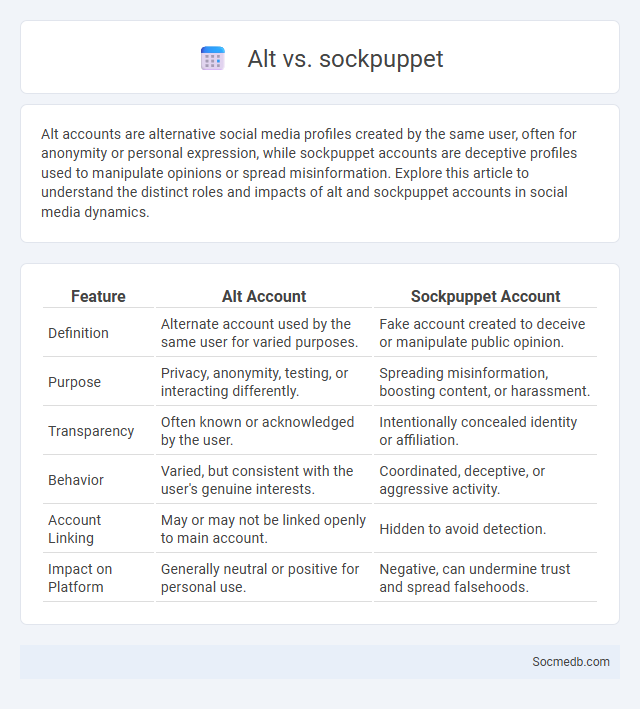
Photo illustration: Alt vs Sockpuppet
Alt accounts are alternative social media profiles created by the same user, often for anonymity or personal expression, while sockpuppet accounts are deceptive profiles used to manipulate opinions or spread misinformation. Explore this article to understand the distinct roles and impacts of alt and sockpuppet accounts in social media dynamics.
Table of Comparison
| Feature | Alt Account | Sockpuppet Account |
|---|---|---|
| Definition | Alternate account used by the same user for varied purposes. | Fake account created to deceive or manipulate public opinion. |
| Purpose | Privacy, anonymity, testing, or interacting differently. | Spreading misinformation, boosting content, or harassment. |
| Transparency | Often known or acknowledged by the user. | Intentionally concealed identity or affiliation. |
| Behavior | Varied, but consistent with the user's genuine interests. | Coordinated, deceptive, or aggressive activity. |
| Account Linking | May or may not be linked openly to main account. | Hidden to avoid detection. |
| Impact on Platform | Generally neutral or positive for personal use. | Negative, can undermine trust and spread falsehoods. |
Understanding Alt Accounts: Definition and Purpose
Alt accounts are secondary social media profiles created to separate specific activities from your primary account, allowing for privacy, experimentation, or niche engagement. These accounts often enable users to express different facets of their personality, manage multiple interests, or interact anonymously within various online communities. Understanding the strategic use of alt accounts can enhance your overall social media experience and content management.
What is a Sockpuppet Account?
A sockpuppet account is a fake online identity created to deceive others, often used to manipulate discussions, inflate popularity, or support a particular viewpoint covertly. These accounts are frequently employed on social media platforms like Twitter, Facebook, and Instagram to generate misleading engagement or disguise the true author's presence. Identifying sockpuppets involves analyzing IP addresses, behavioral patterns, and contradictory content to maintain authenticity and trust in digital communities.
Alt vs Sockpuppet: Key Differences
Alt accounts and sockpuppet accounts are distinct types of social media profiles used for different purposes. Alt accounts are alternate profiles a user creates to engage with content anonymously or explore different interests, while sockpuppet accounts are fake profiles designed to deceive or manipulate opinions by posing as separate individuals. The key difference lies in intent: alt accounts maintain user authenticity, whereas sockpuppets engage in deceptive behavior to influence or disrupt online communities.
Common Uses of Alt Accounts Online
Alt accounts on social media are commonly used for privacy protection, allowing users to share content without revealing their identity. These accounts enable exploring different interests or hobbies without impacting one's main profile or professional image. You can also use alt accounts to engage in communities or activities where you prefer anonymity or want to avoid social judgment.
Typical Motivations Behind Sockpuppet Creation
Sockpuppet creation on social media often arises from the desire to manipulate public opinion, amplify personal viewpoints, or disguise true identity for privacy or deceptive purposes. Users may intend to boost follower counts, sway discussions, or falsely endorse products and ideas. Your awareness of these motivations helps identify inauthentic interactions and promote genuine online engagement.
Ethical Considerations: When Are Alt Accounts Problematic?
Alt accounts on social media become problematic when they are used to spread misinformation, engage in harassment, or manipulate public opinion. Ethical concerns arise when anonymity facilitates deceptive behavior that undermines trust and authenticity within online communities. Balancing privacy rights with accountability is crucial to maintaining a healthy digital environment.
Spotting Sockpuppets: Signs and Red Flags
Spotting sockpuppets on social media involves identifying multiple accounts controlled by the same user to manipulate opinions or create false consensus. Key signs include repetitive posting patterns, similar language or writing styles across profiles, and synchronized activity timing. Red flags also consist of newly created accounts with minimal personal information, disproportionate follower-to-following ratios, and coordinated attempts to flood discussions with identical or highly similar content.
Platform Policies on Alt Accounts and Sockpuppets
Platform policies on alt accounts and sockpuppets are designed to maintain authentic user engagement and prevent deceptive practices across social media channels. These policies typically prohibit the creation of multiple accounts for manipulation, harassment, or evasion of bans, enforcing strict penalties such as account suspension or permanent bans. Understanding these regulations helps you ensure compliance and maintain the integrity of your social media presence.
Notable Cases of Sockpuppetry and Their Impact
Notable cases of sockpuppetry on social media, such as the 2014 Twitter scandal involving fake accounts for political manipulation, reveal how coordinated inauthentic behavior undermines public trust and spreads misinformation. The 2016 U.S. election interference demonstrated the use of sockpuppet accounts to amplify divisive content and skew public opinion. These incidents highlight the critical need for advanced platform security measures and algorithmic detection to mitigate the damaging influence of fake personas in online discourse.
Best Practices for Managing Multiple Online Identities
Managing multiple online identities requires consistent branding across all social media platforms to maintain a cohesive digital presence. Utilizing specialized tools like Hootsuite or Buffer enables efficient scheduling and monitoring of posts, ensuring timely engagement without overlap or confusion. Regularly updating privacy settings and using distinct passwords for each account enhances security and protects personal information in the dynamic social media landscape.
 socmedb.com
socmedb.com